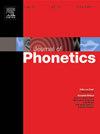F0控制建模的手势场寄存器(GFR)框架
IF 2.4
1区 文学
0 LANGUAGE & LINGUISTICS
引用次数: 0
摘要
在这项研究中,我们引入了一个F0建模框架——我们称之为手势-场-寄存器(GFR)框架——其中F0的产生涉及对相对通用意图的联合控制,以及这些意图如何映射到物理F0值。GFR框架以发音音韵学(articatory Phonology, AP)和任务动力学(Task Dynamics, TD)为基础,认为F0手势是F0控制的基本单位。进一步认为(1)说话人的动态目标F0状态由F0个手势目标在规划域中的混合决定;(2)手势目标和动态目标以归一化值表示,这些归一化值通过F0寄存器的动态控制转换为F0 (Hz)。我们展示了这个框架如何解释各种经验F0模式,并提出了一个案例研究,该案例研究使用参数优化将经验F0轮廓分析为手势激活和寄存器状态的时间序列。在此过程中,我们证明了该框架允许手势目标在话语中保持不变,尽管表面轮廓是高度可变的。生成和拟合F0轮廓的模型代码和示例可以在Github和OSF存储库中公开获得。总体而言,GFR框架为AP/TD下的F0控制提供了一种概念化和建模的新方法,并通过结合规划场和动态寄存器控制机制进一步扩展了AP/TD。本文章由计算机程序翻译,如有差异,请以英文原文为准。
The Gesture-Field-Register (GFR) framework for modeling F0 control
In this study, we introduce an F0 modeling framework – which we refer to as the Gesture-Field-Register (GFR) framework – in which F0 production involves joint control of relatively generic intentions and how those intentions are mapped to physical F0 values. Building on Articulatory Phonology (AP) and Task Dynamics (TD), the GFR framework considers F0 gestures to be the fundamental units of F0 control. It further holds (i) that the dynamic target F0 state of a speaker is determined by the blending of F0 gestural targets in a planning field and (ii) that the gestural targets and dynamic targets are represented in normalized values which are converted to F0 in Hz via dynamic control of F0 register. We show how this framework accounts for a variety of empirical F0 patterns, and we present a case study that uses parameter optimization to analyze empirical F0 contours into a time series of gestural activation and register states. In doing so, we demonstrate that the framework allows for gestural targets to be invariant within an utterance, despite the fact that the surface contours are highly variable. Model code and examples for generating and fitting F0 contours are publicly available in Github and OSF repositories. Overall, the GFR framework provides a novel way of conceptualizing and modeling F0 control under AP/TD and further expands the AP/TD by incorporating the mechanisms of a planning field and dynamic register control.
求助全文
通过发布文献求助,成功后即可免费获取论文全文。
去求助
来源期刊

Journal of Phonetics
Multiple-
CiteScore
3.50
自引率
26.30%
发文量
49
期刊介绍:
The Journal of Phonetics publishes papers of an experimental or theoretical nature that deal with phonetic aspects of language and linguistic communication processes. Papers dealing with technological and/or pathological topics, or papers of an interdisciplinary nature are also suitable, provided that linguistic-phonetic principles underlie the work reported. Regular articles, review articles, and letters to the editor are published. Themed issues are also published, devoted entirely to a specific subject of interest within the field of phonetics.
 求助内容:
求助内容: 应助结果提醒方式:
应助结果提醒方式:


